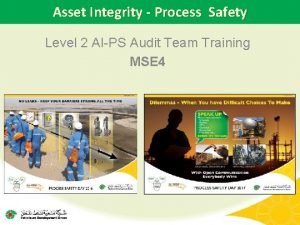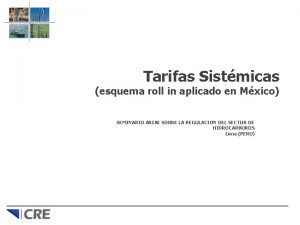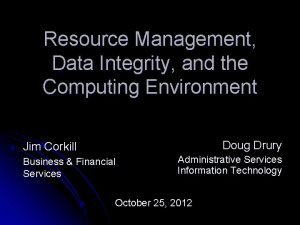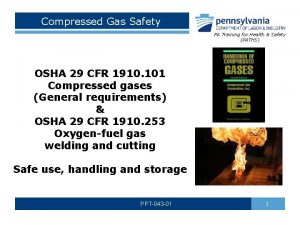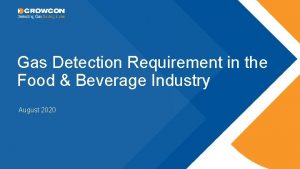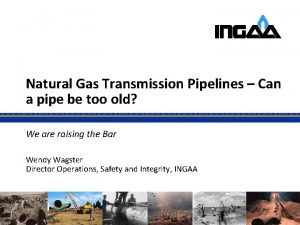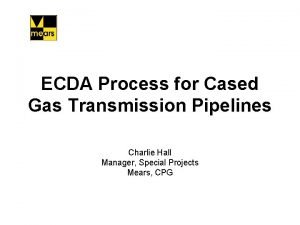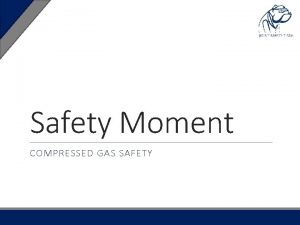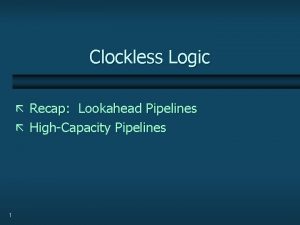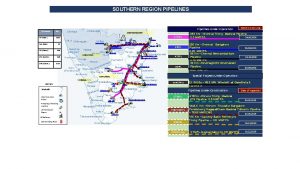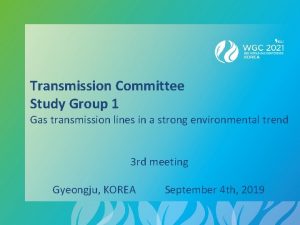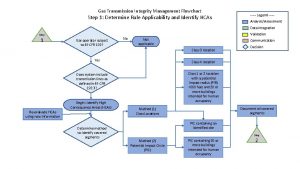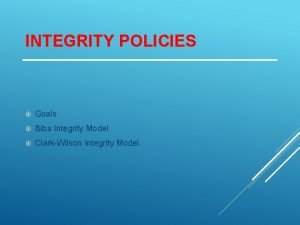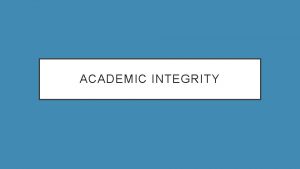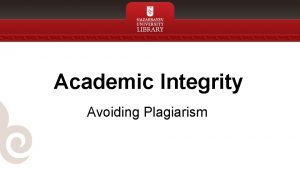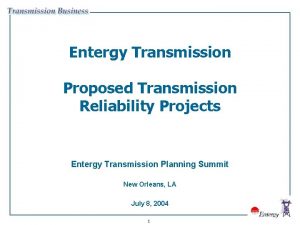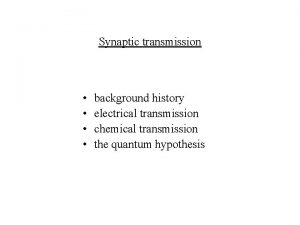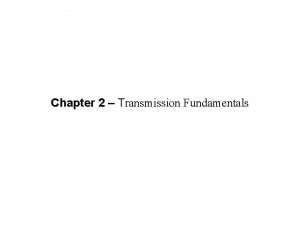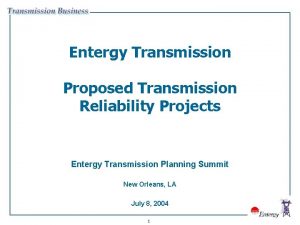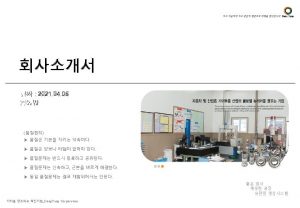Safety Study Integrity Management of Gas Transmission Pipelines































- Slides: 31

Safety Study: Integrity Management of Gas Transmission Pipelines in High Consequence Areas Ivan Cheung 2015 Pipeline Safety Trust Annual Conference November 19, 2015 1

NTSB Background • Independent federal agency • No regulatory authority • Responsible for investigating accidents in aviation, railroad, highway, marine, and pipeline transportation modes • “Board” made up of 5 members appointed by President • Supported by about 400 staff in DC and 4 regional offices • Four modal offices and one technical support office 2

NTSB Research Mandate • NTSB authorization calls for accident investigation as well as safety research “Conduct special studies on matters pertaining to safety in transportation and the prevention of accidents. ” 3

Safety Study vs. Accident Investigation • Differences • Proactive vs. reactive • Breadth vs. depth • “Parties” to investigation • Similarities • • Written report Findings and safety recommendations • Public board meeting 4

Safety Study Process • • 5 Internal assessment of topic suitability Board approval of research proposal Field work and analysis Internal and external technical review Board meeting Safety advocacy Tracking of safety recommendations

Recent Safety Studies • Safety of Experimental Amateur-Built Aircraft • Curbside Motorcoach Safety • Crashes Involving Single -Unit Trucks 6

Objective of This Study • Evaluate the need for safety improvements to gas transmission integrity management programs 7

Motivation • Palm City, FL May 4, 2009 • San Bruno, CA September 9, 2010 • Sissonville, WV December 11, 2012 8

16 Integrity Management Program Elements • Identification of all high consequence areas • A performance plan including the use of specific performance measures • Baseline Assessment Plan • Recordkeeping provisions • Identification of threats to each covered segment, including by the use of data integration and risk assessment • Management of Change process • Quality Assurance process • Communication Plan • Procedures for providing to regulatory agencies copies of the risk analysis or integrity management program • Procedures to ensure that integrity assessments are conducted to minimize environmental and safety risks • A process to identify and assess newly identified high consequence areas • A direct assessment plan, if applicable • Provisions for remediating conditions found during integrity assessments • A process for continual evaluation and assessment • A confirmatory direct assessment plan, if applicable • A process to identify and implement additional preventive and mitigative measures 9

Focus on Select Elements • Identification of all high consequence areas • A performance plan including the use of specific performance measures • Baseline Assessment Plan • Recordkeeping provisions • Identification of threats to each covered segment, including by the use of data integration and risk assessment • Management of Change process • Quality Assurance process • Communication Plan • Procedures for providing to regulatory agencies copies of the risk analysis or integrity management program • Procedures to ensure that integrity assessments are conducted to minimize environmental and safety risks • A process to identify and assess newly identified high consequence areas • A direct assessment plan, if applicable • Provisions for remediating conditions found during integrity assessments • A process for continual evaluation and assessment • A confirmatory direct assessment plan, if applicable • A process to identify and implement additional preventive and mitigative measures 10

Focus Areas 11

Quantitative & Qualitative Research Review Data Analyses Interviews & Discussions Accident Reports Incidents Progress Reports Operators Inspectors Literature Annual Reports Enforcement Industry Associations Relevant Firms Researchers NTSB Investigators NPMS Technical Review 12

Operators’ Perspectives • • 13 7 companies IM plans and relevant documents Semi-structured discussion with focus topics Multiple staff with various responsibilities Demonstration Historical, current, and future Follow-up questions Participated in external technical review

Inspectors’ Perspectives • Federal inspectors and regulator • Teleconference with regional directors and inspectors • Close coordination • State inspectors • 5 states • NAPSR 14

Safety Recommendations • 28 new recommendations • • • 22 to PHMSA 2 to AGA 2 to INGAA 1 to NAPSR 1 to Federal Geospatial Data Committee • 1 reiterated recommendation to DOT 15

HCA Identification • Dependent on GIS and geospatial data • Need of buffering • Identified sites 16

HCA Identification • Publish standards for geospatial data used by pipeline operators (PHMSA, FGDC) • Develop a national repository of geospatial data resources for HCA identification (PHMSA) • Assess limitations of current HCA identification processes (PHMSA) 17

Threat Identification & Risk Assessment • • 18 Eliminating a threat from consideration Interactive threat Dynamic segmentation Complex risk assessment Relative risk approach versus others Use of “weights” Consequence of failure Desire for probabilistic model

Threat Identification • Establish minimum criteria for eliminating threats; documentation guidance (PHMSA) • Update guidance for evaluating interactive threats (PHMSA) • List of threat interactions to evaluate • Acceptable evaluation methods 19

Risk Assessment • Develop risk assessment training for inspectors (PHMSA) • Evaluate safety benefits of 4 approaches (PHMSA) • Update risk modeling guidance (PHMSA) • • • Weighting factors Consequence of Failure calculations Risk metrics and aggregation of risk • Collect and share data to support probabilistic models (AGA, INGAA) • Require all IM personnel to meet minimum professional qualification criteria (PHMSA) 20

Integrity Assessment • In-line inspection (ILI) vs direct assessment (DA) • Usage difference of ILI between interstate and intrastate pipelines 21

Integrity Assessment • Implement plan for eliminating the sole use of DA for integrity assessment (PHMSA) • Develop methods to eliminate operational complications that prevent use of ILI (PHMSA) • Implement strategy for increasing use of ILI, especially for intrastate (AGA, INGAA) • Require all transmission pipelines to be piggable (PHMSA) 22

Data Integration • • • Vaguely defined, hard to evaluation Emergence of GIS Authoritative data source within the organization • Empowering stakeholders at all levels within the organization • Very different levels of adoption 23

Data Integration • Implement plan for all segments of pipeline industry to improve data integration through GIS (PHMSA) 24

Federal and State Oversight • State-to-state and federal-to-state difference • Lack of coordination • State inspectors need additional guidance, supports, and resources • National Pipeline Mapping System (NPMS) needs improvement 25

Federal and State Oversight • Assess and improve protocol guidance, mentorship program, and availability of PHMSA SMEs for consultation (PHMSA) • Modify state program to include federalstate coordination in inspections (PHMSA) • Formalize program to increase state coordination (PHMSA, NAPSR) 26

Data Collection & Analysis • Add HCA method, risk assessment method, and piggable pipe mileage to annual report form (PHMSA) • Add previously identified threats and results of previous assessments to incident report form, and allow multiple root causes (PHMSA) • Analyze relationship between incident occurrences and these threat ID and risk ID factors (PHMSA) • In NPMS, add HCAs and increase positional accuracy of data (PHMSA) 27

Current Status • Held Board meeting on January 27 • Published report and sent recommendations • Government agencies have 90 days to respond • Meeting with organizations that received recommendations • Performing safety advocacy 28

Recommendation update • PHMSA has provided initial responses; majority of them are considered open-acceptable • No response from other recipients at this point 29

For More Information • ivan. cheung@ntsb. gov • nathan. doble@ntsb. gov • www. ntsb. gov • Click on “News & Events” to see presentations from the 1/27/2015 board meeting • Click on “Publications” then “Safety Studies” to read the report 30

 Hemp pdo
Hemp pdo Westwood pipelines
Westwood pipelines Ammonia pipelines
Ammonia pipelines Questar pipelines
Questar pipelines Tom coolidge
Tom coolidge Edge-to-core-to-cloud data pipelines
Edge-to-core-to-cloud data pipelines Pipelines
Pipelines Agt informational postings
Agt informational postings Risk management case study oil and gas industry
Risk management case study oil and gas industry Integrity resource management
Integrity resource management Derive ideal gas equation
Derive ideal gas equation An ideal gas is an imaginary gas
An ideal gas is an imaginary gas Gas law
Gas law Sutherland's law
Sutherland's law Poisonous gas leaked in bhopal gas tragedy
Poisonous gas leaked in bhopal gas tragedy Gas leaked in bhopal gas tragedy
Gas leaked in bhopal gas tragedy Gas reale e gas ideale
Gas reale e gas ideale Flue gas desulfurisation gas filter
Flue gas desulfurisation gas filter Poisonous gas leaked in bhopal gas tragedy
Poisonous gas leaked in bhopal gas tragedy Difference between ideal gas and real gas
Difference between ideal gas and real gas Hukum laju terintegrasi
Hukum laju terintegrasi Gas exchange key events in gas exchange
Gas exchange key events in gas exchange Compressed gas cylinder safety ppt
Compressed gas cylinder safety ppt Oxy acetylene safety rules
Oxy acetylene safety rules Food & beverage gas safety monitors
Food & beverage gas safety monitors What is catzoc
What is catzoc Safety care 2 person stability hold
Safety care 2 person stability hold Process safety vs personal safety
Process safety vs personal safety Ind safety report
Ind safety report Basic safety orientation
Basic safety orientation Basic safety construction site safety orientation
Basic safety construction site safety orientation Electrical safety case study
Electrical safety case study
